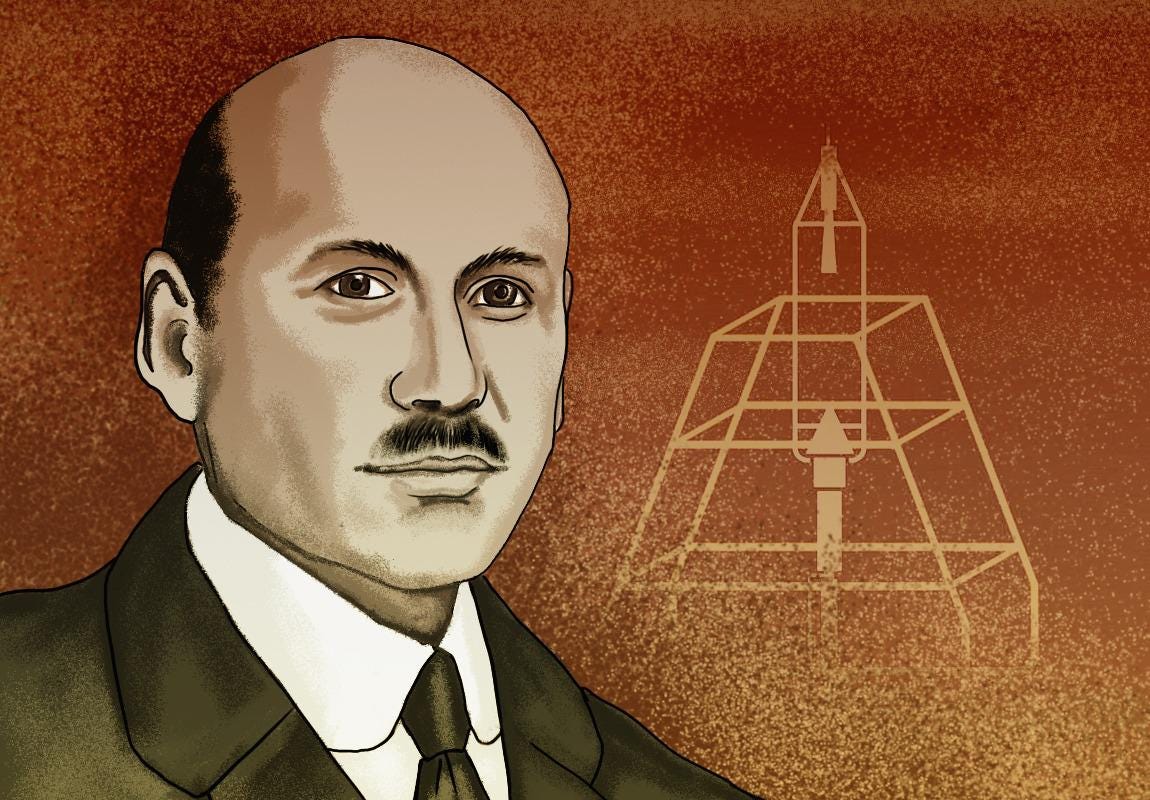Robert Hutchings Goddard was born on October 5, 1882, to a small family in Worcester, Massachusetts as the only child of Nahum Goddard and Fannie L. Hoyt. As a child, Robert was sickly and often spent time observing the sky with his favourite telescope. H.G. Wells's science fiction novel The War of The Worlds and articles by flight expert Samuel Pierpont Langley which were published in the Smithsonian magazine, influenced him. His thoughts were ignited by the fictional fantasies of people travelling to outer space, and he eventually became interested in science and aerodynamics. Robert's greatest dream was to invent a workable space-flight machine like the one he read in his favourite novel.
Goddard was able to secure patents for a liquid-fueled rocket and a multi-staged rocket using solid fuel in 1914.
Goddard completed his graduation from Worcester Polytechnic Institute in 1908, where he studied physics. Then, in 1911, he acquired his doctoral degree in physics from Clark University and, in the following year, took a research fellowship at Princeton University. Later he joined the faculty at Clark University and started his career as a professor of aerospace engineering and physics. However, Goddard always had his childhood fascination with space flight. He started his rocket experiments at the university but initially had difficulty getting funding for the project. Eventually, he was able to convince Smithsonian Institution to support his research.
Goddard was able to secure patents for a liquid-fueled rocket and a multi-staged rocket using solid fuel in 1914. In the following year, he launched the first gunpowder rocket. But the rocket failed to convert energy into motion, and the experiment was unsuccessful. He wrote his first significant treatise, "A Method of Reaching Extreme Altitudes," in 1919 and published it in the Smithsonian magazine. It outlined the challenges of lifting mass high into the atmosphere, detailed his gunpowder rocket experiments and explained how rockets could solve the problems of high-altitude studies. The following year, an expanded report, titled "Report on Further Development of the Rocket Method of Investigating Space", was published.
Following the second report, Goddard shifted his attention to liquid-fueled rockets from the earlier powdered-fueled versions. He devised a rocket design that used a combination of gasoline and liquid oxygen as fuel. Goddard successfully tested his invention on March 16, 1926. The first liquid-fueled rocket, launched from his Aunt Effie's farm in Auburn, Massachusetts, went up 12 meters on a 2.5-second flight that averaged 60 miles per hour. The launch made history and led to further developments in the field of rockets.
In 1943, Goddard became a consultant for Curtiss-Wright Corporation, a leading aircraft firm and director of the American Rocket Society in 1944.
Goddard continued working on creating more advanced and efficient long-range missiles. His 1929 model was equipped with a gyroscope, barometer, thermometer, camera and parachute recovery system to return the rockets. In 1936, he published the work "Liquid Propellant Rocket Development". However, the US government had not recognised the potential of his work. He later moved to Roswell, New Mexico, where he received financial backing from the Guggenheim family and continued his research there until the 1940s. Between 1942 and 1945, Goddard worked for the US navy as director of research in the Bureau of Aeronautics.
In 1943, Goddard became a consultant for Curtiss-Wright Corporation, a leading aircraft firm and director of the American Rocket Society in 1944. He died of throat cancer in Baltimore, Maryland, on August 10, 1945. Esther Christine Kisk, Goddard's wife, played a crucial role in cataloguing his research papers and securing patents after his death. There are 214 patents in Goddard's name, of which 131 were filed by Esther. Unfortunately, Goddard's work and contributions were not well honoured during his life. However, NASA named its first space flight complex Goddard Space Flight Center in recognition of Goddard. Robert Goddard's legacy lives on as the father of modern rocket propulsion.
Thank you for listening. Subscribe to The Scando Review on thescandoreview.com.
Happy Teaching!














Robert Goddard: The Father of Modern Rocket